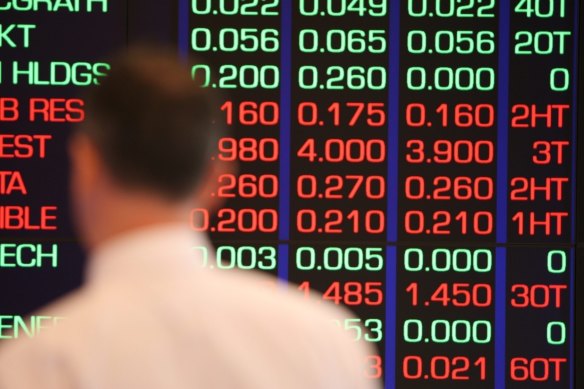‘Fear has started to feed on itself’: The two-day pivot that has shaken up markets
Forty-eight hours. That’s all it took for Australian markets to slash their predictions of two or three more rate rises this year to just one, for economists to warn of a potentially steeper slowdown or a recession, and for this year’s gains on the ASX to largely evaporate.
Usher in a new chapter of fear-based momentum. In market parlance, that’s referred to as ‘risk-off’.
The collapse of three US banks since Friday has spooked investors and customers even in the face of policymakers introducing measures to protect depositors, and taking steps to bolster liquidity and shore up the banking system.

The bank shock has also uncovered the economic and corporate pain the steep rise in interest rates has caused.
It has opened a pandora’s box of hidden vulnerabilities – most particularly overvalued assets including bonds and real estate in investment portfolios. So while the US banking system has averted a systemic crisis, the world’s largest economy is now seen as more vulnerable to a larger downturn.
“Fear has started to feed on itself, and higher uncertainty by itself has triggered its own de-leveraging and de-risking dynamics,” says Barrenjoey’s chief equity strategist, Damien Boey.
Despite bond rates falling, companies are finding it more difficult to borrow money, and its cost is rising in the US.
And when the US economy catches a cold, it spreads to Australia.
What we witnessed on Tuesday in the Australian sharemarket was investors’ realisation of that, with stocks of the economically sensitive banks and energy companies taking the brunt.
Leading the bourse lower, bank shares have taken a dive over the past couple of sessions – Commonwealth Bank shares have been hit more than 3 per cent, ANZ lost 4.8 per cent, National Australia Bank more than 5 per cent and Westpac is off 3.3 per cent.
The fears of a slowing economy and a slump in oil prices also meant energy stocks took a battering, with Santos falling 3 per cent, Whitehaven Coal plunging 5.3 per cent and Woodside Energy falling 3.4 per cent.
Australia’s regional banks were the hardest hit by the financial sell-off – in part because they are considered to be higher risk than the big four.
Banks are traditionally a barometer of economic activity. If lending is curtailed, or the housing market becomes more vulnerable, or net interest margins come under pressure, bank profits are hit.
No one seriously believes that Australian banks are at risk of the kind of strife that has befallen a few banks in the US. These banks were lacking in both prudential controls and risk management. Additionally, they were dealing with very niche sectors, such as small tech venture capital and crypto.
These features are in no way replicated by Australian banks. So time will tell whether the investor treatment of the banking sector this week was overdone.
The bigger question is whether the RBA will see the wobbles in the US as sufficient evidence that external forces will slow down our economy enough to avoid having to continue the relentless tightening of monetary policy.
In other words, will the fallout from the failure of a few specialised banks in the US end up doing the heavy lifting on slowing down the Australian economy?
You would have to think this is what RBA governor Philip Lowe dreams about.
Economists are mixed on whether the RBA’s inflation fight has just been given enough fresh arsenal. Those that were already of the view that the Reserve Bank has pushed rates as high as they need to go see the events in the US as further proof that its board will do some serious damage if it keeps raising rates.
The logic here is that over-tightening creates a whole new set of problems that the RBA will eventually need to fix – not the least of which is rising unemployment.
The economic data released over the past few weeks has shown clear signs that inflation is beginning to cool, but still remains very high.
Some economists are predicting that the RBA will lift rates one more time, but there is an increasing likelihood it will pause next month.
However, the financial markets have spoken clearly. They are predicting rates will peak lower, below 4 per cent, where a week ago were punting on the terminal rate being above 4 per cent.
The Business Briefing newsletter delivers major stories, exclusive coverage and expert opinion. Sign up to get it every weekday morning.
Most Viewed in Business
Source: Thanks smh.com